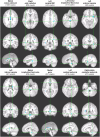Obesity and metabolic syndrome and functional and structural brain impairments in adolescence
- PMID: 22945407
- PMCID: PMC3457620
- DOI: 10.1542/peds.2012-0324
Obesity and metabolic syndrome and functional and structural brain impairments in adolescence
Abstract
Background: The prevalence of metabolic syndrome (MetS) parallels the rise in childhood obesity. MetS is associated with neurocognitive impairments in adults, but this is thought to be a long-term effect of poor metabolism. It would be important to ascertain whether these brain complications are also present among adolescents with MetS, a group without clinically manifest vascular disease and relatively short duration of poor metabolism.
Methods: Forty-nine adolescents with and 62 without MetS, matched on age, socioeconomic status, school grade, gender, and ethnicity, received endocrine, MRI, and neuropsychological evaluations.
Results: Adolescents with MetS showed significantly lower arithmetic, spelling, attention, and mental flexibility and a trend for lower overall intelligence. They also had, in a MetS-dose-related fashion, smaller hippocampal volumes, increased brain cerebrospinal fluid, and reductions of microstructural integrity in major white matter tracts.
Conclusions: We document lower cognitive performance and reductions in brain structural integrity among adolescents with MetS, thus suggesting that even relatively short-term impairments in metabolism, in the absence of clinically manifest vascular disease, may give rise to brain complications. In view of these alarming results, it is plausible that obesity-associated metabolic disease, short of type 2 diabetes mellitus, may be mechanistically linked to lower the academic and professional potential of adolescents. Although obesity may not be enough to stir clinicians or even parents into action, these results in adolescents strongly argue for an early and comprehensive intervention. We propose that brain function be introduced among the parameters that need to be evaluated when considering early treatment of childhood obesity.
Figures



References
-
- Johnson WD, Kroon JJ, Greenway FL, Bouchard C, Ryan D, Katzmarzyk PT. Prevalence of risk factors for metabolic syndrome in adolescents: National Health and Nutrition Examination Survey (NHANES), 2001-2006. Arch Pediatr Adolesc Med. 2009;163(4):371–377 - PubMed
-
- Morrison JA, Friedman LA, Wang P, Glueck CJ. Metabolic syndrome in childhood predicts adult metabolic syndrome and type 2 diabetes mellitus 25 to 30 years later. J Pediatr. 2008;152(2):201–206 - PubMed
-
- Cook S, Auinger P, Li C, Ford ES. Metabolic syndrome rates in United States adolescents, from the National Health and Nutrition Examination Survey, 1999-2002. J Pediatr. 2008;152(2):165–170 - PubMed
-
- Cruz ML, Weigensberg MJ, Huang TT, Ball G, Shaibi GQ, Goran MI. The metabolic syndrome in overweight Hispanic youth and the role of insulin sensitivity. J Clin Endocrinol Metab. 2004;89(1):108–113 - PubMed
Publication types
MeSH terms
Grants and funding
LinkOut - more resources
Full Text Sources
Medical

